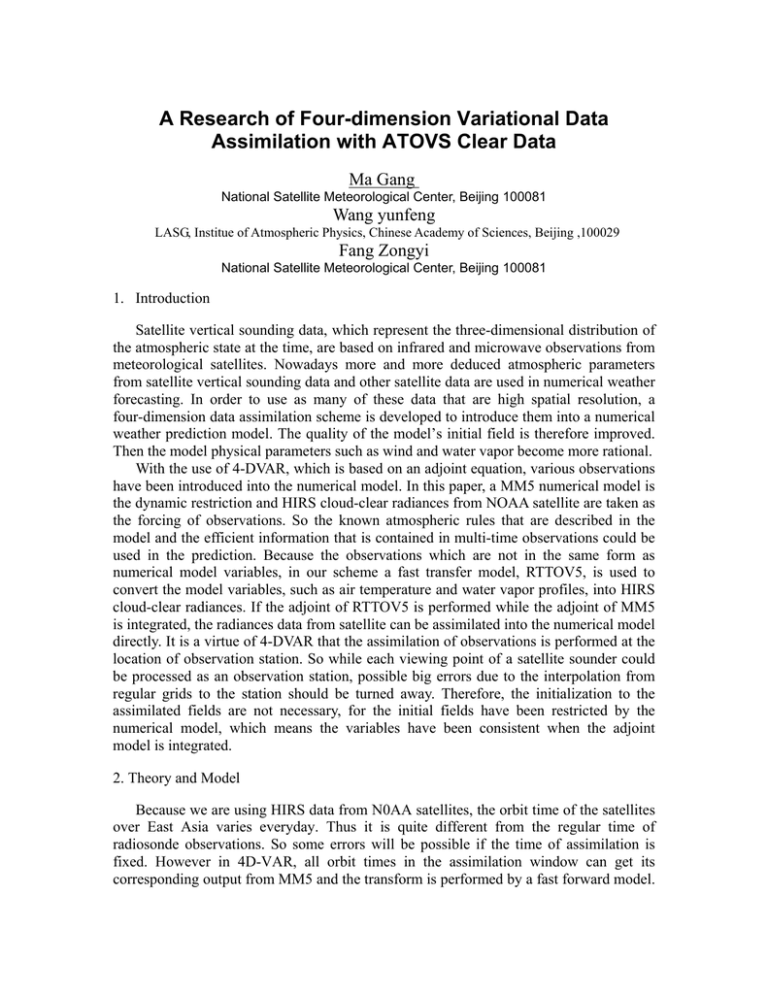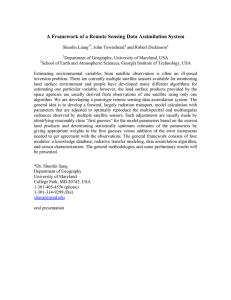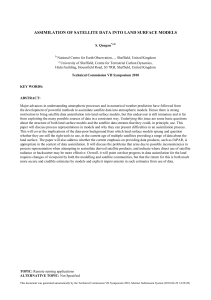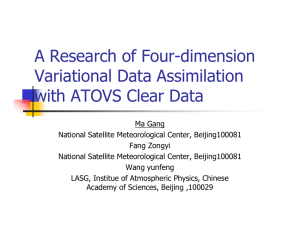A Research of Four-dimension Variational Data Assimilation with ATOVS Clear Data
advertisement

A Research of Four-dimension Variational Data Assimilation with ATOVS Clear Data Ma Gang National Satellite Meteorological Center, Beijing 100081 Wang yunfeng LASG, Institue of Atmospheric Physics, Chinese Academy of Sciences, Beijing ,100029 Fang Zongyi National Satellite Meteorological Center, Beijing 100081 1. Introduction Satellite vertical sounding data, which represent the three-dimensional distribution of the atmospheric state at the time, are based on infrared and microwave observations from meteorological satellites. Nowadays more and more deduced atmospheric parameters from satellite vertical sounding data and other satellite data are used in numerical weather forecasting. In order to use as many of these data that are high spatial resolution, a four-dimension data assimilation scheme is developed to introduce them into a numerical weather prediction model. The quality of the model’s initial field is therefore improved. Then the model physical parameters such as wind and water vapor become more rational. With the use of 4-DVAR, which is based on an adjoint equation, various observations have been introduced into the numerical model. In this paper, a MM5 numerical model is the dynamic restriction and HIRS cloud-clear radiances from NOAA satellite are taken as the forcing of observations. So the known atmospheric rules that are described in the model and the efficient information that is contained in multi-time observations could be used in the prediction. Because the observations which are not in the same form as numerical model variables, in our scheme a fast transfer model, RTTOV5, is used to convert the model variables, such as air temperature and water vapor profiles, into HIRS cloud-clear radiances. If the adjoint of RTTOV5 is performed while the adjoint of MM5 is integrated, the radiances data from satellite can be assimilated into the numerical model directly. It is a virtue of 4-DVAR that the assimilation of observations is performed at the location of observation station. So while each viewing point of a satellite sounder could be processed as an observation station, possible big errors due to the interpolation from regular grids to the station should be turned away. Therefore, the initialization to the assimilated fields are not necessary, for the initial fields have been restricted by the numerical model, which means the variables have been consistent when the adjoint model is integrated. 2. Theory and Model Because we are using HIRS data from N0AA satellites, the orbit time of the satellites over East Asia varies everyday. Thus it is quite different from the regular time of radiosonde observations. So some errors will be possible if the time of assimilation is fixed. However in 4D-VAR, all orbit times in the assimilation window can get its corresponding output from MM5 and the transform is performed by a fast forward model. Thus atmospheric state profiles to radiances from satellite can be carried out correctly. The cost function in the 4D-VAR can be represented as: J ( x) = J b + J s 1 J b = ( X − X b ) T B −1 ( X − X b ) 2 −1 obs J s = ∑∑ [ Fi ( xich ) − yiobs ,ich ] (O + F ) [ Fi ( xich ) − y i ,ich ] T i ich where the vectors X = (u, v, p ' , t , q) are all control variables at initial time, u and v are horizontal wind speed, w is vertical speed, p ′ is the pressure perturbation, T is air temperature and q is the water vapor. During the assimilation, elements in X are adjusted until the end of iteration. And Xb, which is based on an estimation of error covariance B, is obtained from MM5’s analysis. Jb is the background and Js is the forcing from satellite HIRS data. I is the total NOAA16 orbit number contained in the 2 hours assimilation window, ich is the whole number of HIRS channels that are used in the data assimilation. In general, the error covariance-B of background fields only consists of a diagnostic factor and its values are the difference of the model forecast at the initial time and the time of the 6th hours’ integration. This can be represented as: B = X 1 − X 2 2 where X1 and X2 are the control variables from model prediction at the two times. In the satellite HIRS forcing term, the matrix-(O+F) is the summation of the error covariance of the forward model and HIRS data. Usually the biases from simulated radiances to HIRS observations are transacted to get an approximate matrix (O+F+P). If errors from initial profiles are ignored, the matrix could be predigested to (O+F). In fact, the weighting of satellite forcing is set to be 1, while the values of satellite forcing at the first time and prior statistic biases are considered, an experimental error covariance matrix (O+F) is available. In order to decrease computation, the number of HIRS channels which are involved in the data assimilation is selected. Errors of these channels are independent, for the pressure layers of the channels do not overlap. Thus the matrix (O+F) can be treated as a diagonal matrix. In 4D-VAR, y00 is set to be value of the first iteration, then the MM5 forward model starts its integration from t0 to tN which is the end of the assimilation window. While the model is performed, y n0 the atmospheric state vector from MM5, is outputed every 6 hours. When there are satellite observations, radiances of the HIRS channels designed to be involved in the assimilation are calculated by RTTOV5 to get the value of satellite forcing. The adjoint of MM5 starts performing at tN after the execution of the MM5 forward model. The initial perturbation value of the conjugation function: δ * y (t N ) = WN ( y N0 − y N ) is the initial field of the adjoint model. The basic states of the adjoint model are available from y n0 and the gradients of satellite forcing are obtained from the adjoint of RTTOV5 in which the initial values of the adjoint are set to be bias from the simulated radiances to the satellite observations: WN ( y n0 − y n ) . Then, a finite memory semi-Newton algorithm is used to get a new initial field y01 for the MM5 forward model along an optimal convergence direction of cost function. Using iteration of the semi-Newton algorithm, various y0k are obtained until the optimal with a more satisfying precision. Finally (y0)p is set to be the initial field of the MM5 forward model to check the possible improvement in the forecast atmospheric state field and precipitation due to the introduction of satellite data in the numerical model. 3. The Experiments and Results Prior to the assimilation, though the gradients of the forward model and the adjoint of RTTOV5 MM5 have been tested, it is still essential to test the gradients of the 4D-VAR after the coupling of these two models while the potential transmission mistakes between them are considered. While ψ(α) is set as single precision, its value varies with α can be represented as: α0 =0.0000000E+00 ++<α_00=9.9999990E-05>++ I=1 α= 0.10000E-04 F(A)= 0.1002861300E+01 I=2 α= 0.10000E-05 F(A)= 0.9989470500E+00 I=3 α= 0.10000E-06 F(A)= 0.1019896300E+01 I=4 α= 0.10000E-07 F(A)= 0.9372019800E+00 I=5 α= 0.10000E-08 F(A)= 0.5512952800E+00 To check the impact on meso-scale weather prediction by the atmospheric vertical sounding data from satellite, HIRS data from NOAA16 are introduced into a MM5 4D-VAR system to simulate a rainstorm that developed from 21 to 25 July 2002. Both data of background fields and the initial fields from the MM5 forward model are attained from analyzed fields of T106. 100hPa is set as the top of MM5. Since the top of MM5 is far lower than the top of RTTOV5 (0.1 hPa), some climate profiles are used from 100hPa to 0.1 hPa. A cubic spline interpolation is used to get air temperature and water vapor on pressure levels of RTTOV5 from these variables on the pressure levels of MM5. Then an experiential quality control is designed to remove satellite data with large bias to the simulated radiances and a cloud mask method is also used to make sure that all satellite data are located in cloud-clear areas. The length of the assimilation window is 2-hours, so two orbits of NOAA16 are involved in the window from 12 UTC to 14 UTC on July 21. Some preliminary tests show that data from all HIRS channels cannot confirm the best prediction if all these data are introduced into the 4D-VAR. Therefore it is essential to select part of the channels to use in the data assimilation. According to the pressure level of the weighting function of every HIRS channel, some channels could be independent to each other. If channels, such as O3 channel and short wave window channels (channel 17-19) are ignored, data from 9 HIRS channels are used in the data assimilation while these independent channels are considered. The center of the test domain is set as 25°N, 120°E. Total grids are 61*61, grid spacing is 45km (figure 1). The primary precipitation from 21 to 22 July 2002 is distributed from 30°N, 112°E to 30°N, 120°E. Because of the cloud cover, HIRS data in one orbit of NOAA16 are used in the data assimilation, only one of the two precipitation centers (one located at 29°N, 114°E, and the other is at 24°N, 109°E) is included in the orbit area. After 24-hours integration of the MM5 forward model, the simulated precipitation center is at 30°N, 114°E, compared to the total precipitation at 30°N, 117°E of 20.0 mm in the control test, the assimilated total precipitation of 33.1m which is 50% more than the prior value. And the total precipitation and the location of west center are not different in the two tests. The test shows that assimilation of HIRS data from satellite can get certain improvement to numerical model prediction. Due to the impact of cloud, meso-scale forecasting in cloud area could not get any change. Because only microwave sounding data from satellite can be used in cloud areas, the assimilation of these data could potentially make an improvement to predictions in cloud areas. Figure 1. Test terrain of the MM5. Figure 2. The observed precipitation from 21-22 July. Figure 3. Total 24-hours’ precipitation in control test (right) and assimilation test with satellite data (left).



